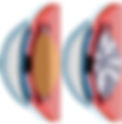18 results found for "glaucoma"
- Glaucoma
View of a retinal fundus showing optic nerve damage related to glaucoma (yellow circle). Secondary types of glaucoma (glaucoma caused by other ailments) include pseudoexfoliation syndrome , pigment dispersion syndrome , neovascular glaucoma, inflammatory glaucoma, trauma, tumours, irregular Glaucoma/pressure lowering drops in ocular hypertension can prevent future glaucoma. If caught early, primary glaucoma is very manageable with either drops or surgery.
- Pigment Dispersion Syndrome
These elevated pressures can lead to glaucoma in about 35% of affected individuals. is no known way to prevent pigment dispersion syndrome but treatments can ensure it does not lead to glaucoma Treatments · Regular glaucoma testing with imaging and peripheral vision testing. · Laser not a condition that will affect vision but it does put the individual at a higher risk of developing glaucoma
- Pseudoexfoliation Syndrome (Exfoliation Syndrome)
Treatments · Regular glaucoma testing with imaging and peripheral vision testing every 6-12 months . · Glaucoma drops that lower eye pressure. · Laser trabeculoplasty removes the fibrous It leads to glaucoma in only about 50% of individuals but this type of glaucoma has a worse prognosis than primary open angle glaucoma because the condition is so variable and difficult to treat. Typically though, treatment can ensure glaucoma never advances to a point where the effects can harm
- Retinal Vein Occlusion
Risk Factors Age (over 65), high blood pressure , high cholesterol, diabetes , glaucoma/elevated eye CRVO, the possibility of full recovery is low due to the high likelihood of macular degeneration , glaucoma can stimulate the growth of blood vessels (neovascularization) into the retina and/or iris and cause glaucoma
- Optic Disk Drusen
. · Glaucoma drops to decrease the chance of a second anterior ischemic optic neuropathy episode common and in most cases do cause blind spots that slowly enlarge over time, much like those seen in glaucoma
- Fuch's Dystrophy (Guttatta)
genetically inherited condition that typically affects women more than men and is very loosely correlated to glaucoma improve a patients’ vision to 20/50 but its 5-year rejection rate is 15% in healthy eyes and 50% in glaucomatous eyes (eyes with glaucoma ).
- Myopia (nearsightedness)
However, the higher the myopia, the higher the risk of conditions like early cataracts , glaucoma , macular In fact, any amount of myopia increases odds of getting glaucoma by about 50% and early cataracts by
- Cataracts
dermatitis, neurofibromatosis, systemic diseases that cause uveitis (inflammation inside the eye), glaucoma These complications may include allergies to eye drops , elevated eye pressures and glaucoma , uveitis
- Optic Disk Pit
It can also lead to glaucoma -like blind spots with age.
- Hyperopia (farsightedness)
However, smaller eye sizes can increase the risk of angle closure glaucoma .
- Herpes Zoster Ophthalmicus
cases of HZO can cause permanent corneal scarring, nerve damage, permanent neuralgia pain, cataracts, glaucoma
- Giant Papillary Conjunctivitis
sutures after ocular surgery, scleral buckles after a retinal tear or detachment , filtering blebs after glaucoma












